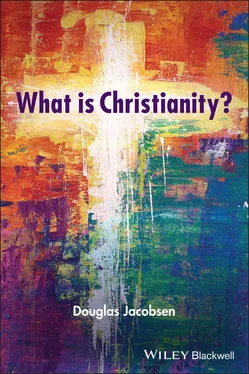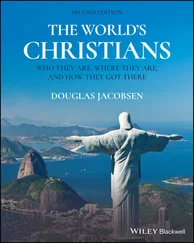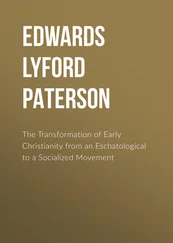Emergence of the Great Church
During the late second and early third centuries, a group of Christian bishops from the major cities of the Roman Empire launched a concerted effort to bring more structure, order, and male control to the movement. The immediate goal was to establish their own authority to govern the movement, and their proposals were based on a new theory called “apostolic succession.” Apostolic succession operates along the same lines as a modern self-perpetuating board of trustees that chooses its own successors. For the early Christian movement, apostolic succession was established when Jesus selected his disciples and invested them with special authority to lead the movement in his post-ascension absence and when Christ’s apostles then chose their successors and gave them special authority to lead the church. Those leaders subsequently had chosen their successors, and so on right up to the present day.
Bishops who could trace their lineage of leadership succession back to Jesus viewed themselves as having special authority within the movement and as having a special responsibility for imposing order on a movement that many of them considered to be much too freewheeling. Slowly these bishops formed themselves into a network of orthodox (“right-believing”) Christian leaders who began establishing boundaries around their wing of the Christian movement, which they called the Great Church or simply the Church. Identifying heresy (wrong belief) became a focus of attention, and volumes with titles like Against All Heresies , written by Irenaeus who was bishop of the city of Lyon (France) from around 180 to 202, became standard texts for deciding who was in and who was outside the Great Church. Formal church membership now became a major concern, and Cyprian (208–258), the bishop of Carthage, bluntly declared that no one could “have God as Father who does not have the church as mother.” 3The bishops were never able to attract or corral everyone who called themselves followers of Jesus into the Great Church, but over time a majority of Christians became associated with their version of Christianity, and it developed into the mainstream of the movement.
There were advantages and disadvantages to Christianity’s new organization and visibility. On the plus side, better organization helped the movement grow, since a standardized faith was easier to explain to others. On the negative side, persecution of Christians increased. Before 200, Christians in the Roman Empire were only occasionally subjected to persecution, primarily because the movement was too inconsequential to attract much attention. Once Christianity became better organized and more socially visible, Christians became useful scapegoats and popular targets for abuse. Persecution was especially intense between the years 250 and the early 300s when the Roman economy weakened and social unrest increased. It is estimated that five to ten thousand Christians were put to death during these years. That number represents less than 1 percent of all the Christians who lived in the empire at the time, but the executions were highly visible events – they were part of the “entertainment” that was staged in the colosseums and circuses in every Roman city – and having the courage willingly to die for one’s faith became woven into the fabric of Christian identity.
The Roman Imperial Church
At the height of the worst persecution Christians had ever faced, a dramatic change took place. The Roman Emperor Constantine (who ruled from 306 to 337) converted to Christianity, and he halted the violence immediately. Soon he was actively favoring the Christian movement, and later in the century, under the rule of Theodosius I (379–395), Christianity as defined by the Great Church became the official religion of the Roman Empire.
It is difficult to assess the impact of Christianization on the empire as a whole, but the effect on the Christian movement itself was unquestionably substantial. Before Constantine, being a Christian involved personal risk. Suddenly, not being a Christian became a liability. Masses of people flocked into the movement, and the Christian population surged during the century following Constantine’s conversion, catapulting from 10 or 15 percent of the Roman population to 75 percent or more. Accumulating more Christians is not equivalent, however, to developing better Christians, and there is some evidence that levels of religious piety and devotion decreased because people joined the movement out of convenience rather than out of conviction. The age of martyrdom also came to an end, and monasticism developed as a new way for individuals to express their complete devotion to God. Known as “white martyrs” (because no blood was involved), monks and nuns figuratively died to the world. Leaving their old lives behind, they fled to the desert where they could fully devote themselves to God with no earthly distractions.
Back in the world, as opposed to the desert, faith and politics were becoming ever more intertwined, and the institutional Great Church reaped the benefits. In 325, the Emperor Constantine himself called the bishops into council at Nicaea and charged them with developing a statement summarizing the core beliefs of true Christianity, so that every other alternative version of Christianity could be condemned and hopefully eliminated. Bishops from the Great Church readily agreed, and in doing so effectively turned the Great Church into the Imperial Church of the Roman Empire. The outcome of the council’s work became known as the Nicene Creed, and it was used as a guide both in Christian worship and in identifying and persecuting other Christians who were deemed heretical. The Nicene Creed is still used as a statement of faith in many churches today.
Now able to operate freely in public with official support, the bishops of the Imperial Church increased their efforts to impose order and clarity on the Christian movement. One crucial task was to finalize the official canon (table of contents) of the New Testament. A number of different canons had been suggested over the years, but by the early 300s a consensus was beginning to emerge. The Didache (mentioned above) was one of the last documents to be eliminated from the New Testament list, and the book of Revelation (also known as the Apocalypse) was accepted only reluctantly because it was so susceptible to anti-imperial interpretation. The matter was firmly settled in the year 405 when the Palestinian monk and scholar Jerome (347–420) finished his Latin translation of the New Testament, and this text, known as the Vulgate , almost immediately became the definitive biblical text for most Christians. The New Testament used by the Persian Church had five fewer books (eliminating 2 Peter, 2 John, 3 John, Jude, and Revelation) and the Ethiopian New Testament had eight additional books, but most Christians of the time affirmed Jerome’s twenty-seven-book canon.
With the approval and generous financial support of Roman authorities, Christians began building large and spectacular church buildings. Before the year 300, Christians had generally worshiped in relatively small quarters, often meeting in a house or similarly sized building. Once Christianity became the official religion of the empire, modest and provisional structures no longer seemed adequate or appropriate. New buildings were needed that could compete with or even outshine the grandeur of the older temples of Roman paganism, and enormous amounts of money were devoted to building massive, architecturally impressive church buildings called basilicas. As the architecture of the Christian movement changed, the visual art inside those buildings also changed. Most noticeably, Jesus got older and sterner. In the early centuries of Christianity, Jesus was typically pictured as a young, beardless shepherd carrying a lamb over his shoulders. The new portrayals typically depicted Jesus as a bearded, middle-aged judge or ruler on a throne (see Figure 1.1). Simultaneously, Christian worship became more elaborately choreographed, tailored to fit the magnificence of the new church buildings. Worship began to feel much more like an imperial court ritual than like a gathering of friends. Together, these changes signaled a major shift in Christian identity. Christianity was no longer the faith of social outcasts; it had become the faith of the prominent and powerful.
Читать дальше












